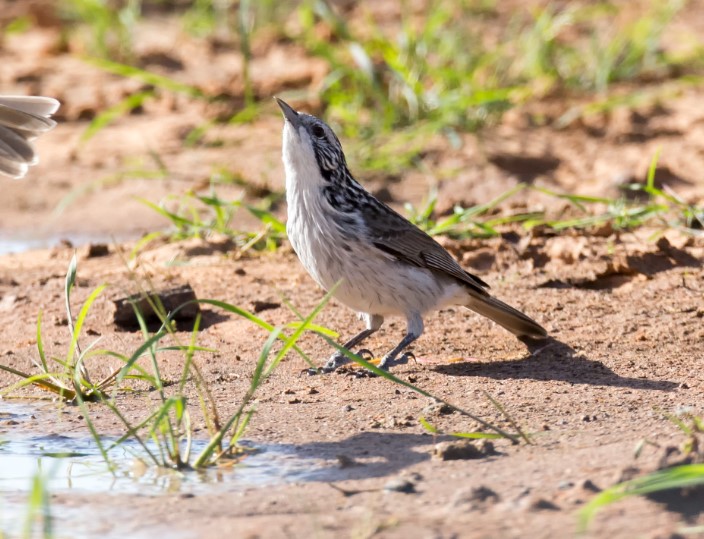Habitat: With its short and dagger-like bill, the striped honeyeater (Plectorhyncha lanceolata) of eastern inland woodlands is more of an insect- and fruit-eater than a nectar-eater. It most often forages in the middle inner strata of trees, primarily native inland pines and casuarinas on the central coast, but also eucalypts and acacias. It lives in small, fairly sedentary colonies of two to eight members.
As it hops briskly about undercover, it inspects leaves and probes branchlets for insects and caterpillars. It also takes berries, including mistletoe and peppercorn beans. Having a brush-tipped tongue, it will take nectar from the flowers of eucalypts, eremophila, and native tobacco Nicotiana.
Songs are rarely heard, as most flying is done in erratic, undulating movements between food trees and cover, or splash baths and drinking. While pairs may wander locally and irruptions are frequent, they may retain a permanent territory within a consistently productive habitat despite local wandering. They advertise with a rollicking, bubbling song at any time of the day.
Often, the pair duets, perched almost side-by-side on high but sheltered branches. Both adults provide food for their children. The adults are pugnacious in their defense of the nest and attack trespassers by whistling shrilly and landing on branches, the tail rising and falling as they do so.
The Striped Honeyeater is not related to any other member of its family. It has a generally streaked appearance, with long and spiky feathers on the throat and upper breast, which gave rise to its scientific name, lanceolata.

Identification: Both sexes are similar. Head and face to upper neck are white, boldly striped with black. The lores and brows are white. The back is grey-brown striped dusky. The wings and square-cut tail are plain gray-brown. The throat of the upper breast is white with spiked feathers. The lower breast to the undertail is off-white, finely streaked, and dusky, and the flanks are grey. The eyes are brown. The bill is pale blue-grey and dark-tipped. Feet are pale blue-grey. The immature (as adults) are dull.
Vocalizations: The striped honeyeater call is made of rollicking trills that rise and fall, as calls or as a song when protracted and often duetted: cherree-cherree-chirrarip- chirrarip-cheeree-chew. It sings singly or often in small groups.
Nesting and Breeding: Nesting and breeding occur in August–January. A nest is a deep cup shape, 75 x 95 mm inside, of fine dry grass or thin dry grass stems, covered outside with plant down or wool, and often decorated with emu feathers. The nest is lined with grass, suspended at several parts of the rim from thin leafy twigs at the end of a drooping branch 1–10 meters above ground.
The striped honeyeater usually uses old material for nest building. Striped honeyeaters are known to dive-bomb people and animals approaching their nests when they come too close, but they are not territorial. In contrast to other species of honeyeaters, it rarely shows aggression toward other species.
Eggs: Striped honeyeater lays three or four dull white eggs, usually marked with brown-red and underlying pale purple-grey, sometimes forming a cap or zone at the larger end; oval, about 23 x 17 mm. incubation by both parents, who sit continually for alternating periods of around 20 to 25 minutes for 15 to 17 days. The young leave the nest in about two and a half weeks.
Distribution: The striped honeyeater is moderately common in woodlands and scrubby country in eastern Australia. Sedentary, or nomadic, in autumn
Alternative Name: It is also known as the Lanceolated Honeyeater.
Size: The striped honeyeater is about 210–230 mm (about 9.1 inches) in length.
Races: There are no races.
Related Reading: White-fronted Honeyeater (Phylidonyris albifrons)
